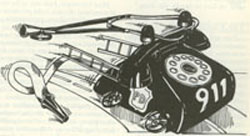
OVER 2,000 emergency telephone numbers currently assigned to police, fire and ambulance agencies in Illinois will be changed by December 31, 1985. With the signing of House Bill 911 (Public Act 79-1092) on September 25, 1975, by the governor, the state's 65 phone companies and 2,200 emergency agencies are faced with the complicated task of implementing the 911 emergency telephone number on a statewide basis. Proposed as an easy to remember and quick method for citizens to summon emergency help, 911 has gained an impressive list of supporters in recent years including officials of public safety and many of the telephone companies.
Public surveys commissioned by 911 planners have shown that in many areas less than 50 per cent of the citizens questioned knew the telephone numbers of their own emergency service agencies, and at least 20 per cent of those not knowing proper numbers were also uncertain as to what agencies to call in the event of an emergency. Spokesmen for the phone companies reveal that the old method of dialing "0" for help is not the best way of contacting an emergency service. The gradual reduction of manned operator centers created by the automation of telephone switching centers has ended the era of locally based operators for many areas in Illinois. Thus, an operator reached through dialing "0" could be as far as 200 miles away from the location of the emergency and probably unfamiliar with local emergency services.
| Speed is a key factor in the successful handling of emergencies. In promoting 911, Illinois Bell Telephone (IBT) has published estimates from law enforcement officials stating that if police can arrive on the scene within 90 seconds of a crime, 60 per cent of the criminals are caught. A Stanford Research Institute study done in Florida indicates that a reduction of only one minute in fire engine response time could probably on a yearly statewide basis prevent property loss from fire which would equal the yearly costs of a 911 system. Additionally, medical authorities suggest that the saving of precious seconds in the initial response time for ambulances and medical personnel will reduce the death rate in heart attacks, injury, accidents and other medical emergencies. |

|
Realizing the impact of the ATT endorsement, Illinois telephone companies eventually banded together and formed the "911 Telephone Industry Committee" to keep track of 911 developments. The first 911 system in the state was installed in 1968. The phone companies have played an active role in the development of 911 legislation and testified when the proposal was debated in the General Assembly.
Jeff Rogerson, statewide coordinator of 911 for IBT, credits state Rep. Harold Katz (D., Glencoe) with the successful promotion of 911 in Illinois. Rogerson says that early drafts of the bill were looked upon with reservation by the phone companies for several reasons. Of major concern to both the phone companies and governments involved was who would pay the costs of the 911 changeover. Plans and proposals for funding were debated at length, and most of the cost was placed on local governments and the phone companies. A second point which drew opposition in early drafts of 911 legislation was the date for total implementation of the system. Early drafts of the bill set deadlines at 1981 and then 1982. The
June 1977 / Illinois Issues / 21
final bill set the deadline at the end of 1985.
"We debated three different versions of the 911 bill in the judiciary committee before the bill reached the form that it was finally passed in," Rogerson said. "I give Harold Katz as sponsor of the bill a lot of the credit for finally developing a workable piece of legislation. It was no easy task getting so many parties including the phone companies, fire, law enforcement and medical groups to agree on how to handle this thing."
The timetable
| Final sections of the 911 law place additional responsibility on local emergency services in the state. It requires that no citizen be refused emergency service because they are outside the jurisdictional boundaries of an emergency service dispatched to their aid. To overcome a possible situation where an emergency service might refuse to respond beyond its legal boundaries of responsibility, the law requires that all emergency agencies within a 911 dispatching system enter into joint mutual aid agreements of cooperation. The law further directs that emergency agencies also enter into mutual aid agreements with other similar agencies which have contiguous boundaries but which are in different 911 dispatching systems. The law states that once an emergency service is dispatched to the aid of a citizen it shall render that service even if it is outside its boundaries. Copies of these mutual aid agreements must be filed annually with the Ill. CC and the attorney general starting in 1987. |
|
Realizing that many local governments looked upon 911 as a complicated and confusing mandate, the 111. CC has set out to make the transformation as easy as possible. Representatives from law enforcement, fire service, medical emergency and other related public safety agencies, as well as the phone companies' 911 Telephone Industry Committee, were all asked by the Ill. CC to serve on a statewide 911 Policy Committee. Goal of the group is to develop support for 911 and to identify potential problems in the changeover period.
The undone work22 / June 1977 / Illinois Issues